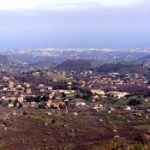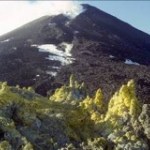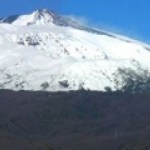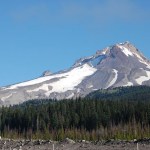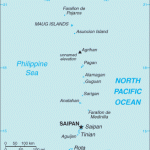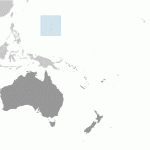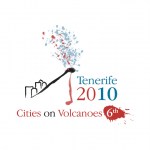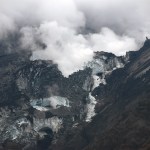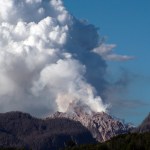The final part of Etna Week, brought to us by guest blogger Dr. Boris Behncke. Check out Part 1 and Part 2 as well!
Etna Volcanic hazards
By guest blogger Dr. Boris Behncke.
Etna is one of the most active volcanoes on Earth, and a population of nearly one million people dwell on its flanks, many in areas that have been repeatedly invaded by lava flows during the historical period. A few villages have been constructed very close to the vents of eruptions only a few hundred years old.
Top: Residential areas surrounding numerous pyroclastic cones on the lower southeast flank of Etna, seen…
volcano scientist
This is Part 2 of 3 from guest blogger Dr. Boris Behncke. Check out Part 1 here.
The current dynamics and activity of Etna
by guest blogger Dr. Boris Behncke
The recent behavior of Etna is characterized by nearly continuous eruptive activity from the summit craters and eruptions from new vents on the flanks at intervals of a few years to decades. Summit eruptions vary from quiet lava emission to mild Strombolian explosions to high-discharge-rate Hawaiian to sub-Plinian style lava and fire fountaining accompanied by the emplacement of fast-moving lava flows; usually the strongest activity…
Etna Week Part 1
Mount Etna - Brief Anatomy of an Exceptional Volcano
By guest blogger Dr. Boris Behncke.
Italy truly deserves to be called "the Cradle of Volcanology" - not only because it hosts virtually all existing types of volcanoes and volcanic rock compositions, and seven of its volcanoes have had confirmed eruptions during the historical period (i.e. the past approximately 2700 years), but also because the earliest surviving eyewitness account of an eruption was written in Italy, the first volcano observatory and the first geothermal power plant were built in Italy, and three…
Italy's Mt. Etna erupting in November 2006.
Well, I am currently off in the wilderness, but that doesn't mean that things aren't still hopping here at Eruptions. We are lucky to have Dr. Boris Behncke of the INGV Catania as that blogger and he brings us a three-part series on Mt. Etna on the island of Silicy. That means this week is Etna Week here on Eruptions, so for all of you chomping at the bit for more information on the Italian volcano, you are going to get it (and then some).
modern-day satellites who can watch that same summit from space.
I think you're all going to love this series…
Earlier this summer, we had a chance to ask Sally Kuhn Sennert of the Smithsonian Institution/USGS Global Volcanism Program questions about her job as the main writer of the well-loved Weekly Volcanic Activity Report. Well, now here are the answers!
Sally Kuhn Sennert of the Global Volcanism Program in front of Mt. Rainier, Washington.
Q&A Sally Kuhn Sennert:
Q: Could you describe how you go about putting together the weekly update?
A: If time permits, I would start to gather information on Friday when particular sources post their weekly summaries. The majority of the information…
Mt. Hood in Oregon, taken August 2008. Image by Erik Klemetti. Click on the image to see a larger version.
Quick news!
I'm not going to go into too much depth right now about the recent study published in Nature Geoscience on Mt. Hood in Oregon - I plan to talk about it more in a few weeks. Why is that? Well, the lead investigator on the study, Dr. Adam Kent of Oregon State University, is a friend of mine (and occasional Eruptions commenter) so I plan to get the details from him before posting. I was also peripherally associated with some of this work - mostly in the field acting as a pack…
Our tour of the Marianas begins SW of Guam. In this area the volcanoes are submerged and make up a region known as the Southern Seamount Province. Our first stop is Tracey Seamount, which lies 30 km west of Guam. Tracey is a ~2 km tall cone and volume of ~45 km3 It is one of the smaller volcanoes in the Mariana arc; Pagan, contains about 2200 km3 of material (Bloomer et al., 1989). It has a sector collapse on its western flank and resembles a submarine Mt. St. Helens. It was investigated by the ROV Hyper-Dolphin from the R/V Natsushima in Feb. 2009, which revealed that the cone is map up of…
This week I welcome Dr. Ed Kohut as a guest blogger here on Eruptions (while I am off in the Sierras doing some field work). I've known Ed for 10 years now - we were both graduate students in igneous petrology at Oregon State University - and we are both Massachusetts natives. Ed was in the Coast Guard before getting degrees at University of Rhode Island and Boston University before heading of to Oregon State for a Ph.D., where he worked on melt inclusions in minerals. One of his major research areas is magmatism in the Mariana Islands and he was nice enough to put together a look at the…
Mineral King valley in California.
Well, we are in the peak of the summer, so Eruptions will be running a bit of summer schedule while I'm off away from the interweb tubes. First off, from July 11-20, I'll be off in the mountains, doing some much-needed fieldwork with my (first) undergraduate research student. We'll be up in the Mineral King area of Sequoia National Park looking at some old rhyolites and granites - we're talking Triassic and Jurassic submarine and subaerial calderas! We'll hopefully be taking a look at zircons in these rocks to help constrain the timescales of these…
As a part of my continuing Q&A series, I am pleased to announce that Sally Kuhn Sennert, compiler and author of the weekly Global Volcanism Program Volcanic Activity Reports, is the next up to take your questions. A little bit about Sally:
Sally Kuhn Sennert graduated with a Bachelor's degree in Anthropology from the University of Pittsburgh in 1997. She worked with non-human primates for several years before deciding to switch gears and pursue her first love, Geology. She returned to the University of Pittsburgh, and completed her Master's degree in 2003 under the direction of Dr. Mike…
This week is the Cities on Volcanoes conference - now in its sixth iteration. This year the conference is in Tenerife in the Canary Islands and while I wish I could be there, I'm not. However, we can all live vicariously through Dr. David Calvo, who will be sending daily updates from the meeting. He's been busy with the usual first day activities of someone helping run a meeting, but here is his first blurb from Tenerife:
CitiesonVolcanoes6 started just today at Puerto de la Cruz (Tenerife, Spain), and right now more than 700 people are sharing their knowledge about volcanism and volcanic…
The GÃgjökull outlet glacier on Eyjafjallajökull, showing the steaming lava flow carving its way through the glacier. Image taken May 5, 2010 by Dr. Joseph Licciardi.
A quick update on the ongoing activity at Eyjafjallajökull:
The activity at the volcano continues to be more explosive during the last few days than it was in the previous week, leading to more potential for airspace closures over Europe if the winds were to shift. Currently, the VAAC ash advisory only seems to suggest that even Spain may get a taste of the ash sometime tomorrow, but most of Europe will be OK. However,…
Here it is, my attempt to recap a year's worth of volcanic events. By no means is this supposed to capture every event, but rather the highlight/lowlights and what most captivated me during 2009. I'll be announcing the winner of the 2009 Pliny for Volcanic Event of the Year tomorrow.
Waimangu Geothermal Valley in New Zealand, taken in January 2009 by Erik Klemetti.
January
The year started out with a trip to New Zealand (well, for me at least) and vistas of the Waimangu Valley, formed in the 1886 eruption of Tarawera on the North Island. We were also still thinking about the late 2008…
Here is Part 2 of the Q&A with Dr. Boris Behncke. You can also check out Part 1.
Undated image of Stromboli in eruption.
(Shirakawa Akira) 1. Would a large scale eruption (VEI 5 or greater) of Mt. Etna like the ones occurred in 122 BC and 1500 BC (disputed) be possible again in the foreseeable future? Or is the volcano slowly "dying" although the last eruption ended in July 2009 has been one of the longest ever recorded?
2. Not really related to volcanism, but close: does INGV plan to distribute seismic data from seismic stations of its Rete Sismica Nazionale, including stations from…
First off, I want to thank Dr. Behncke for taking the time to answer your questions - and also, thank you to all who sent him some thought-provoking questions. In fact, the questions and answers take up about 12 pages of text, so the Q&A will be divided into two parts.
If you want to see one of the previous in the Q&A series, check out:
Dr. Jonathan Castro.
Question and Answer with Dr. Boris Behncke of the Italian National Institute of Geophysics and Volcanology in Catania.
Dr. Boris Behncke.
Questions for Dr. Boris Behncke
(Bernard Duyck) Qu'en est-il de l'évolution du mécanisme…
Just a reminder ...
Etna erupting in November 2002.
If you have any questions for Dr. Boris Behncke, who runs Italy's Volcanoes along with the volcanology page for the Italian National Institute of Geophysics and Volcanology in Catania, please send them in to me at
. I've got some good question so far!
The first Q&A with Dr. Jonathan Castro was such a success, I'm going to try to make this a regular feature. On that note, Eruptions reader Dr. Boris Behncke has volunteered to be the second geologist to take the plunge. Here is a little about Boris and his work:
I've studied geology first in Bochum, Germany, then finished my Master's in Kiel, Germany (in 1996), before hopping south to Catania, where I did my Ph.D. in 2001. I live in Sicily since early 1997, but first visited the Italian volcanoes in 1989, and happen to be at Etna when it produced a spectacular eruption just on schedule.…
A few weeks ago I asked you to submit questions on the 2008-present Chaiten eruption in Chile to pose to Dr. Jonathan Castro. Dr. Castro recently had a paper on the ascent rates of Chaiten rhyolite published in Nature and he kindly volunteered to answer your questions. Here are the answers to selected questions ... enjoy!
Chaiten in Chile erupting in 2009. Image by Dr. Jonathan Castro.
Dr. Jonathan Castro
Biography:
B.S. from Humboldt State University
Ph.D. from University of Oregon*
Currently a Research Geologist at CNRS-Institut for Sciences de la Terre, Oreans, France
Soon moving on to…
Happy Earth Science Week!
Mt. Baker in Washington, USA.
The Mount Baker Volcano Research Center (MBVCC) run out of Western Washington University has posted a series of new pictures and movies of the summit region of Mt. Baker (taken from 2006 to 2009). They also sent out links to some great images of the recently-exposed edge of the old crater rim on Mt. Baker. The crater had been buried by the ice/snow cap on the volcano until this year, but John Scurlock was able to capture a photo of the rim of the crater from an airplane this summer. The grey layer is ash/tephra likely from activity at…
I mentioned this at the end of the post on recent Nature paper by Castro and Dindwell on the speed of rhyolite magma ascent at Chaiten, but I'll break it out to get your attention:
>Do you have a burning question about the Chaiten magma you'd love to be able to ask Dr. Castro? He has kindly offered to answer some questions about Chaiten and his research for Eruptions readers. Send me your questions at
and I'll choose some of them for Dr. Castro to answer. I'll post the interview and the answers to your questions here on the blog.
So do it! Send me your questions for Dr. Castro!
